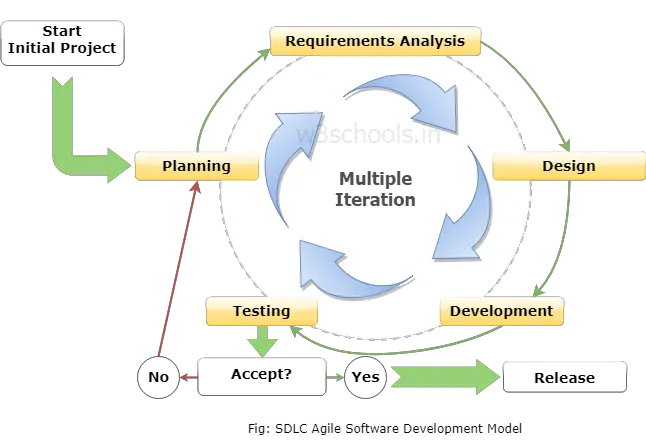The iterative waterfall model was popular in the olden days for completing a project. But, following this model, the software developer had to face various issues and difficulties especially when customers request for handling change or there is an update in the system requirement. So to mitigate such problems and drawbacks in older models, the new model was incorporated in the year 1990, and they proposed the model with a name Agile Software Development. In this tutorial, you will learn about the structure and working of the agile model.
What is the Agile Model?
The Agile software development model was mainly intended for helping developers build a project which can adapt to transforming requests quickly. So, the most important endeavor for developing the Agile model is to make easy and rapid project achievement. For attaining this task, developers need to preserve the agility during development. Agility can be achieved by correcting the progression to the project by eliminating activities which may not be crucial for that specific project.
For each iteration, engages a cross-functional group of developers functioning concurrently on various areas of product development such as:
- Planning
- Requirements Analysis
- Design
- Development
- Unit Testing
- Deployment
Once all the iterations are completed giving rise to a successful product, it is displayed to the customers and other stakeholders who will approve and accept the final product.

More about Agile Methodology of Software Development
Essentially, the Agile model is a collective iteration grouped to do the development practice of a product. These procedures share some essential qualities but do have assured little differences between each of them. Here are lists of different kinds of Agile SDLC models that are used by software development companies. These are:
- Feature-driven development
- Crystal
- Atern
- Scrum
- Unified process
- Extreme programming (XP)
- Lean development
Amongst them, Scrum, Lean and Extreme programming are some of the most popular forms of Agile development methodologies.
Manifesto Principles of Agile Model
- For launching a close connection with the client throughout the development as well as to achieve a public perception of a variety of requirements; each Agile development process typically comprises of a customer representative within the development team.
- This model also relies on effective software deployment methodology rather than having comprehensive documentation.
- This model also provides regular release of incremental versions of the product to its customers and stakeholders in an interval of 2 to 3 weeks.
- Incorporation of change in customer's system requirement is always welcome entertained at any point of development.
- The agile model needs all its team members to be efficient, and there should have to be healthy communication among them for better development of the product. It is found that efficient and proper communication between team members is possible by the use of face-to-face discussion rather than exchanging emails or through online medium.
Benefits of Agile Methodologies
- Involves pair programming which reduces the number of errors in the development or coding phase and is better than a single programmer doing all the hard part.
- This model trims down the entire development time of any project.
- After each iteration, customers and stakeholders of the project can get a fair idea the updated software that is being developed by the agile model. So, any change in the system can be addressed at any iteration.